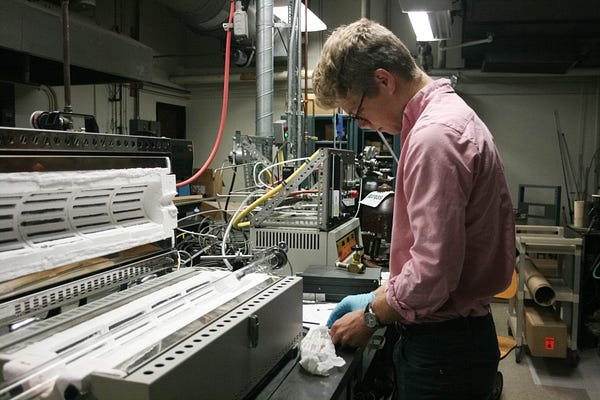Shrinking Glaciers Inspire Swiss Student’s Energy Research
By Erica Andersen
This profile is part of series on the Vagelos Integrated Program in Energy Research, or VIPER. Learn more about VIPER here.
As a rising junior in VIPER, Yann Pfitzer is spending the sweltering Philadelphia summer in a lab, designing and testing ultrathin plates that could one day be part of systems that convert extreme heat to electricity.

Pfitzer’s interest in energy research, however, began in a much cooler environment. He’s from Switzerland, where alpine skiing has a rich history and remains a major tourist draw. Even during the summer, when the snow is scarce, ski racers from all over the world train on the country’s famed glaciers.
Pfitzer himself raced competitively and trained on the glaciers every summer for years. He watched the ice and snow recede beneath his feet. “Every year, we’d have to walk another 30 feet,” he says. For Pfitzer, this was a clear sign of a changing climate. “All glaciers are shrinking in Switzerland,” he says. “That made climate change very real to me.”
“One degree might not mean a lot to people, but for me it can mean between a foot of snow and a few inches of rain,” he says. “That makes a big difference if you want to ski.”
Pfitzer recognizes that the far-reaching effects of climate change extend beyond his favorite sport, but his summers on Swiss glaciers nevertheless allowed him to form a personal connection to a global issue. “If everyone saw the personal impact it had on their lives, I think we’d be in a much different place,” he says.
In Pfitzer’s case, it motivated him to investigate the effects of our current energy system as well as alternate ways to power our civilization. “Very early on, it became clear to me that there were going to be big changes in energy both because of our dependency on non-renewable sources,” he says, “and because of the need to switch to cleaner forms of energy to avoid harming our environment further.”
Pfitzer is currently the vice president of the University of Pennsylvania ski and snowboard team, but he didn’t come to the U.S. for the comparatively mild slopes of the mid-Atlantic region. He was drawn by the high-powered technical and scientific education he could pursue within VIPER.

“It was always a big debate for me whether I would stay in Switzerland for college because they have great technical schools at quite a lower cost. They’re heavily subsidized for Swiss citizens,” Pfitzer says. But he saw value in the American higher education system, and was particularly drawn to Penn or VIPER’s unique energy focus.
This summer, he has been working in the lab of Igor Bargatin, Class of 1965 Term Assistant Professor in Mechanical Engineering and Applied Mechanics in Penn’s School of Engineering and Applied Science, to develop a new structure for ultrathin metamaterial plates. The plates are specially engineered for their flexibility and strength; they are the thinnest material of their type that can be picked up by hand. Eventually, they may improve the efficiency of high-temperature energy converters.
The existing plates have a pattern that resembles a honeycomb. Pfitzer is working to change the geometry to make the plates as strong and flexible as possible. He creates and tests new designs using a computer model so that when the lab fabricates the material, they will already have an expectation of how it will behave. Then he tries to match the results that he sees in the software to the theory that would explain it. The task is somewhat complicated by the fact that he’s only halfway through his undergraduate degree.
“The material’s a little bit more advanced than what I’ve learned so far in classes,” Pfizer says, but he’s grateful for the early exposure to complicated theory through his research experience.
His work isn’t all simulations. Pfitzer also heats up the existing ultrathin plates so that the lab can analyze how they respond to extremely high temperatures. To do so, he places the wafers in a narrow glass tube that extends through a furnace, which glows orange as the temperature within climbs to 1,200 degrees Celsius. As these plates might one day be used in high-temperature energy converters, it’s crucial that the lab understands how they behave in the conditions they might encounter in such an application.
Pfitzer enjoys the challenge of VIPER’s dual-degree requirement, and is pursing mechanical engineering as well as earth science with a concentration in environmental science. “I came in thinking I was doing eight years of work in four,” he says. But with careful planning under the direction of VIPER managing director Kristen Hughes, the course load became much more manageable, and he’s hopeful that he may also be able to squeeze in a minor or two. He’s particularly interested in sustainability management and hopes to enter the business side of energy after graduation.
“I’ve always wanted to work in energy,” Pfitzer says. He has enjoyed the well-rounded approach that VIPER takes toward training young researchers, which includes the ability to talk about his work to a variety of different audiences. “Explaining my research is something I really enjoy doing,” he says. “It can really motivate you to get back in the lab.”
“I spent an entire summer making this small piece on the computer screen,” Pfitzer says, but then he reminds himself that such work “can take us one step closer to a sustainable future” in ways that he and others might not have even considered.
“People don’t even realize that most of these applications exist,” he says. “You really feel like you’re on the cutting edge.”
